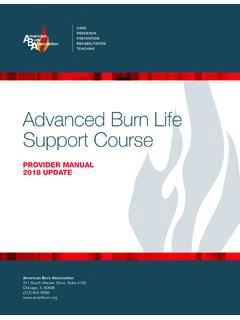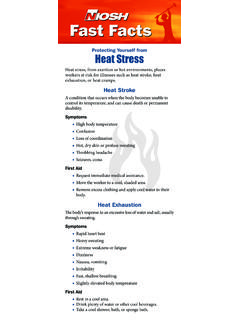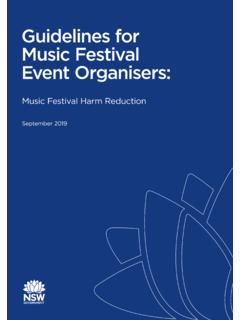Transcription of American Burn Association SCALD INJURY PREVENTION …
1 American burn Association SCALD INJURY PREVENTION . Educator's Guide A Community Fire and burn PREVENTION Program Supported by the United States Fire Administration Federal Emergency Management Agency General Background Information on SCALD Burns High risk groups Time and temperature relationship Selected burn and SCALD INJURY statistics for children Fact Sheets for Community Distribution Hot food and beverage scalds Microwave SCALD PREVENTION Tap water SCALD PREVENTION Water heater thermostat settings and SCALD PREVENTION Other causes of SCALD burns Getting the Message to the Media Sample press releases Sample Public Service Announcements References/Resources PowerPoint Slide Presentation with Instructor Comments Evaluation Form Community Fire &
2 burn PREVENTION Programs SCALD INJURY PREVENTION Campaign GENERAL BACKGROUND INFORMATION ON SCALD BURNS. Although SCALD burns can happen to anyone, young children, older adults and people with disabilities are the most likely to incur such injuries. Most SCALD burn injuries happen in the home, in connection with the preparation or serving of hot food or beverages, or from exposure to hot tap water in bathtubs or showers. Severe scalds also occur in the workplace, typically when pipes or valves fail while carrying or regulating the flow of steam. Both behavioral and environmental measures may be needed to protect those vulnerable to scalds because of age or disability, or because they do not have control of the hot water temperature in multi-unit residential buildings.
3 The severity of a SCALD INJURY depends on the temperature to which the skin is exposed and how long it is exposed. The most common regulatory standard for the maximum temperature of water delivered by residential water heaters to the tap is 120 degrees Fahrenheit/48. degrees Celsius. At this temperature, the skin of adults requires an average of five minutes of exposure for a full thickness burn to occur. When the temperature of a hot liquid is increased to 140o F/60o C it takes only five seconds or less for a serious burn to occur 1 . Coffee, tea, hot chocolate and other hot beverages are usually served at 160 to 180o F /71-82o C, resulting in almost instantaneous burns that will require surgery. Since immediate removal of the hot liquid from the skin may lessen severity, splash and spill burns may not be as deep as burns suffered in a bathtub.
4 High risk groups Young Children Young children have thinner skin resulting in deeper burns than adults for the same temperature and exposure time to a scalding substance. The proportion of a child's body that is exposed to any given amount of a scalding substance is also greater: the same cup of spilled coffee will burn a much larger percent of a small child's body. Small children also have little control of their environment, less perception of danger and less ability to escape a burning situation on their own. Children grow fast and can reach new, dangerous things every day. They do not realize that hot liquids burn like fire. Older Adults Older adults, like young children, have thinner skin so hot liquids cause deeper burns with even brief exposure.
5 Their ability to feel heat may be decreased due to certain medical conditions or medications so they may not realize water is too hot until INJURY has occurred. Because they have poor microcirculation, heat is removed from burned tissue rather slowly compared to younger Older adults may also have conditions that make them more prone to falls in the bathtub or shower or while carrying hot liquids. People With Disabilities or Special Needs 1. Moritz, AR, Herriques, FC Jr. Studies of thermal injuries: II The relative importance of time and surface temperature in the causation of cutaneous burns. Am J Pathol 1947; 23:695-720. 2. Stone, M, Ahmed J, Evans J. The continuing risk of domestic hot water scalds to the elderly.
6 Burns 2000; 26:347-350. Community Fire & burn PREVENTION Programs SCALD INJURY PREVENTION Campaign Individuals who may have physical, mental or emotional challenges or require some type of assistance from caregivers are at high risk for all types of burn injuries including scalds. The disability may be permanent or temporary due to illness or INJURY and vary in severity from minor to total dependency on others. Mobility impairments, slow or awkward movements, muscle weakness or fatigue, or slower reflexes increase the risk of spills while moving hot liquids. Burns to the lap are common when a person attempts to carry hot liquids or food while seated in a wheelchair. Moving hot liquids can be extremely difficult for someone who uses a cane or walker.
7 Sensory impairments can result in decreased sensation, especially to the hands and feet, so the person may not realize if something is too hot. Changes in a person's intellect, perception, memory, judgment or awareness may hinder the person's ability to recognize a dangerous situation (such as a tub filled with scalding water) or respond appropriately to remove themselves from danger. Other risk factors Studies have shown that children who live in crowded housing and in families with low socioeconomic status are at higher risk for SCALD burns. Other related risk factors may include a lack of safe play environments, single and/or young mothers, and poor maternal education. 3. While the basic principles of SCALD PREVENTION apply to the general population the additional concerns affecting these high risk groups must be addressed.
8 SCALD injuries result in considerable pain, prolonged treatment, possible lifelong scarring, and even death. PREVENTION of SCALD injuries is always preferable to treatment and can be largely accomplished through simple changes in behavior and in the home environment. Time and Temperature Relationship to Severe Burns 4. Water temperature Time for a third degree burn to occur o o 155 F 68 C 1 second o o 148 F 64 C 2 seconds 140o F 6 0o C 5 seconds o o 133 F 56 C 15 seconds o o 127 F 52 C 1 minute 124o F 51o C 3 minutes o o 120 F 48 C 5 minutes o o 100 F 37 C safe temperature for bathing 3. Delgado J, Ramirez-Cardich ME, Gilman RH, et al. Risk factors for burns in children: crowding, poverty and poor maternal education.
9 Inj Prev 2002:8:38-41. 4 Moritz, , Herriques, Jr., ibid. Community Fire & burn PREVENTION Programs SCALD INJURY PREVENTION Campaign Selected burn and SCALD INJURY Statistics for Children 5. Total burns In 2003, an estimated 83,300 children ages 14 and under were treated in hospital emergency rooms for burn -related injuries. 15,000 children are hospitalized annually with burn injuries. 1,100 children die each year from fire and burns. SCALD burns Approximately 21,000 children were treated for SCALD burns. Among children ages 4 and under hospitalized for burn -related injuries, an estimated 65% are treated for SCALD burns. The total annual cost of SCALD burn -related deaths and injuries among children ages 14 and under is $44 million.
10 Children 4 and under account for more than 90 percent of these costs. 5. National Safe Kids Campaign. Facts About Childhood Burns. 2006. Community Fire & burn PREVENTION Programs SCALD INJURY PREVENTION Campaign SCALD PREVENTION FACT SHEETS. FOR COMMUNITY DISTRIBUTION. Hot food and beverage scalds Microwave SCALD PREVENTION Tap water SCALD PREVENTION Water heater thermostat settings and SCALD PREVENTION Other causes of SCALD burns Community Fire & burn PREVENTION Programs SCALD INJURY PREVENTION Campaign HOT FOOD AND BEVERAGE SCALDS. Cooking-related scalds are common in all age groups, but are especially serious for young children, older adults and people with disabilities. Children get burned when they upset cups of coffee, hot tea, hot chocolate or other hot beverages, grab dangling appliance cords or pot handles, or pull on hanging tablecloths.










